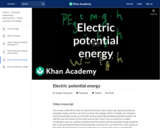
Introduction to electric potential energy. Created by Sal Khan.
- Subject:
- Applied Science
- Engineering
- Material Type:
- Lesson
- Provider:
- Khan Academy
- Provider Set:
- Khan Academy
- Author:
- Sal Khan
- Date Added:
- 05/22/2008

Introduction to electric potential energy. Created by Sal Khan.
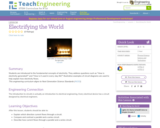
This lesson introduces students to the fundamental concepts of electricity. This is accomplished by addressing questions such as "How is electricity generated," and "How is it used in every-day life?" The lesson also includes illustrative examples of circuit diagrams to help explain how electricity flows.

Building on concepts taught in the associated lesson, students learn about bioelectricity, electrical circuits and biology as they use deductive and analytical thinking skills in connection with an engineering education. Students interact with a rudimentary electrocardiograph circuit (made by the teacher) and examine the simplicity of the device. They get to see their own cardiac signals and test the device themselves. During the second part of the activity, a series of worksheets, students examine different EKG print-outs and look for irregularities, as is done for heart disease detection.
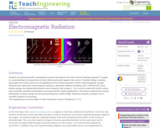
Students are presented with a hypothetical scenario that delivers the unit's Grand Challenge Question: To apply an understanding of nanoparticles to treat, detect and protect against skin cancer. Towards finding a solution, they begin the research phase by investigating the first research question: What is electromagnetic energy? Students learn about the electromagnetic spectrum, ultraviolet radiation (including UVA, UVB and UVC rays), photon energy, the relationship between wave frequency and energy (c = λν), as well as about the Earth's ozone-layer protection and that nanoparticles are being used for medical applications. The lecture material also includes information on photo energy and the dual particle/wave model of light. Students complete a problem set to calculate frequency and energy.

Students learn about the scientific and mathematical concepts around electromagnetic light properties that enable the engineering of sunglasses for eye protection. They compare and contrast tinted and polarized lenses as well as learn about light intensity and how different mediums reduce the intensities of various electromagnetic radiation wavelengths. Through a PowerPoint® presentation, students learn about light polarization, transmission, reflection, intensity, attenuation, and Malus’ law. A demo using two slinky springs helps to illustrate wave disturbances and different-direction polarizations. As a mini-activity, students manipulate slide-mounted polarizing filters to alter light intensity and see how polarization by transmission works. Students use the Malus’ law equation to calculate the transmitted light intensity and learn about Brewster’s angle. Two math problem student handouts are provided. Students also brainstorm ideas on how sunglasses could be designed and improved, which prepares them for the associated hands-on design/build activity.
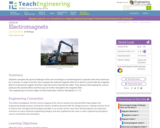
In this activity, the students will complete the grand challenge and design an electromagnet to separate steel from aluminum for the recycler. In order to do this, students compare the induced magnetic field of an electric current with the magnetic field of a permanent magnet and must make the former look like the latter. They discover that looping the current produces the desired effect and find ways to further strengthen the magnetic field.
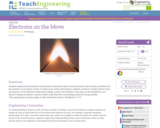
Students learn about current electricity and necessary conditions for the existence of an electric current. Students construct a simple electric circuit and a galvanic cell to help them understand voltage, current and resistance.

In this animation produced by WGBH and Digizyme, Inc., see how molecules of DNA are separated using gel electrophoresis, and how this process enables scientists to compare the molecular variations of two or more DNA samples.

Students gain a better understanding of the different types of materials as pure substances and mixtures and learn to distinguish between homogeneous and heterogeneous mixtures by discussing an assortment of example materials they use and encounter in their daily lives.
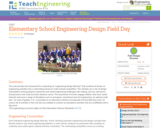
This unit provides the framework for conducting an “engineering design field day” that combines 6 hands-on engineering activities into a culminating school (or multi-school) competition. The activities are a mix of design and problem-solving projects inspired by real-world engineering challenges: kite making, sail cars, tall towers, strong towers and a ball and tools obstacle course. The assortment of events engage children who have varied interests and cover a range of disciplines such as aerospace, mechanical and civil engineering. An optional math test—for each of grades 1-6—is provided as an alternative activity to incorporate into the field day event. Of course, the 6 activities in this unit also are suitable to conduct as standalone activities that are unaffiliated with a big event.

This resource from the AMERICAN EXPERIENCE Web site, which contains both an interactive activity and illustrated text, looks at the composition of different types of steel and their impact on technology.
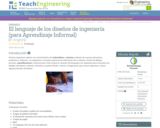
Los estudiantes aprenden a transmitir claramente a otros sus diseños de coches impulsados por el viento.
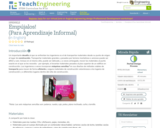
Los estudiantes diseñan y construyen un dispositivo de transporte a pequeña escala.
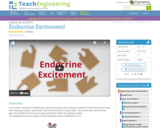
In this activity, students are divided into a group of hormones and a group of receptors. The hormones have to find their matching receptors, and the pair, once matched, perform a given action. This activity helps students learn about the specificity of hormone-receptor interactions within the endocrine system.
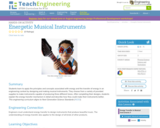
Students learn to apply the principles and concepts associated with energy and the transfer of energy in an engineering context by designing and making musical instruments. They choose from a variety of provided supplies to make instruments capable of producing three different tones. After completing their designs, students explain the energy transfer mechanism in detail and describe how they could make their instruments better.

Watch students as they conduct an energy audit on a home and gain hands-on experience for a career in the green energy industry, in this video adapted from ATETV.

Demos and activities in this lesson are intended to illustrate the basic concepts of energy science -- work, force, energy, power etc. and the relationships among them. The "lecture" portion of the lesson includes many demonstrations to keep students engaged, yet has high expectations for the students to perform energy related calculations and convert units as required. A homework assignment and quiz are used to reinforce and assess these basic engineering science concepts.
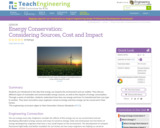
Students are introduced to the idea that energy use impacts the environment and our wallets. They discuss different types of renewable and nonrenewable energy sources, as well as the impacts of energy consumption. Through a series of activities, students understand how they use energy and how it is transformed from one type to another. They learn innovative ways engineers conserve energy and how energy can be conserved in their homes.
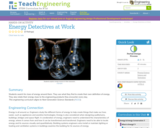
Students search for clues of energy around them. They use what they find to create their own definition of energy. They also relate their energy clues to the engineering products they encounter every day.
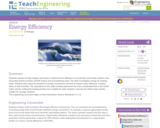
This Lesson provides two different activities that require students to measure energy outputs and inputs to determine the efficiency of conversions and simple systems. One of the activities includes Lego motors and accomplishing work. The other investigates energy for heating water. They learn about by products of energy conversions and how to improve upon efficiency. The teacher can choose to use either of these or both of these. The calculations in the water heating experiment are more complicated than in the Lego motor activity. Thus, the heating activity is suitable for older students, only the Lego motor activity suitable for younger students.